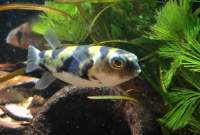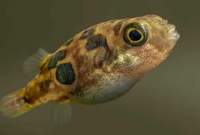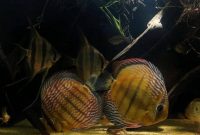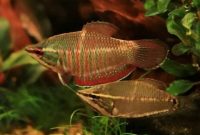The Ultimate Kissing Gourami Fish Care Sheet – Helostoma temminckii or commonly people call “kissing gourami”, are medium-size tropical gourami fish species under the family Helostomatidae. These freshwater fish species are also known as “kissing fish or kissers fish.”
Many gourami fish types come from the Osphronemidae family, just only kissing gourami under the family Helostomatidae. These gouramis species native to Southeast Asia, primarily originating from Indonesia and Thailand.
In the wild, they usually inhabit the slow-moving, shallow with dense vegetation. Pond and marshes are the most favorite habitat for them. Some populations are also found in the blackwaters.
The people in that countries commonly farmed them to use as food fish. These gouramis are used fresh for pan-frying, broiling, steaming, or baking, so they have economic values. And now, these fish have become popular aquarium fish among hobbyists because they’re hardy, easiest to keep with nice appearances.
Read Also: Complete Tropical Pearl Gourami Fish Care Sheet

The Ultimate Kissing Gourami Fish Care Sheet
These gourami types also have a labyrinth organ that is the same as other gouramis species before written. The labyrinth fish can be taking air directly to the water surface, which is a beneficial skill. The labyrinth fish species can be survived well in extreme conditions where the oxygen level is low.
The kissing gouramis normally sells around $5 per piece. You can found them in the fish store or online marketplace such as eBay. However, the dwarf gourami fish are the easiest found in the pet store. So you may have to look around some shops before you found the kissing gouramis.
Appearance And Behavior
The kissing fish known can live to reach up to 5-7 years. In good maintenance and healthy aquarium, they can live longer even some have been known can live until 25 years old.
These freshwater fish species can grow to reach up to 30 cm or 12 inches in total length when they are fully mature. In captivity usually grow smaller. Typically of gourami species, they have heavily compressed body laterally and deep.
Generally, you can found them in 3 main colors: silver-green, which is often called a “Green kisser,” pinkish or flesh-colored, and piebald or speckled variety. The wild form is the green variety; they have dark lateral stripes on the bodies and fins with brown color.
Read Also: The Complete Guide To Keeping Sparkling Gourami Fish
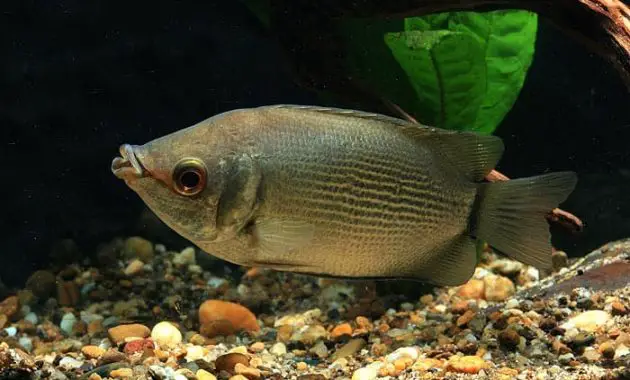
Buy The Kissing Gourami Fish Only On eBay
In captivity, a mutated variety has been bred for the aquarium industries. This variety has a round and short body that makes them look too cute. Many people prefer this variety and become popular than the wild form.
Unfortunately, this variety is known as weaker and shorter lifespan than the wild kissing gourami variety.
The unique feature of these kissing fish is their mouth. They have a mouth that is highly protrusible, forward-facing, and the lips are filled with small horny teeth. Besides, their jaw has an extra joint that enhances their mouth’s angle to open larger, and they can eat more food.
Their anal and dorsal fins are short, running on their bodies from the back of the head until the tail fin. And their pectoral fins are more rounded and longer.
Distinguishing sexes male and female is quite hard. Almost there are no characteristics in appearances to distinguish them, although the females are usually heavier than the males.
Read Also: Complete Honey Gourami Care Guide – Keeping, Tank Setup, Appearance, Feeding, Breeding
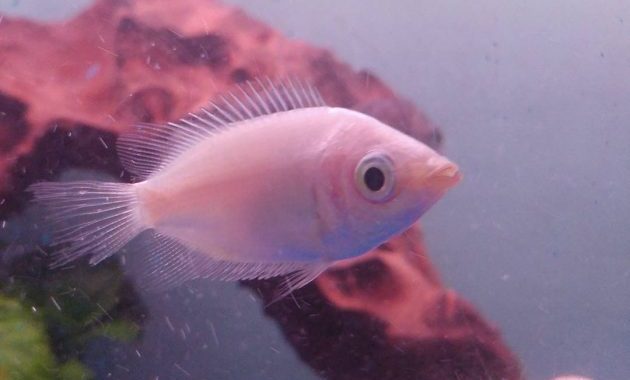
In the water, they have often seen “kissing.” That act actually is fighting over the territories and known as “mouth fight,” commonly between the males. It will reduce when they mature and obviously define their own mating areas.
Although they are quite peaceful species, sometimes their aggression is directed at their tank mates. They also occasionally hit the sides of their tank mates, where they can remove their slime coats. If it happens oftentimes, you should separate them.
Like other labyrinth fish species, they tend to prefer swimming in the aquarium’s middle and upper levels. And, you will see them reach the water surface to take the air frequently or if oxygen level on the waters is bad conditions. These gourami types prefer soft water for breeding.
Housing Or Tank Setup
As we know, the kisser fish are territorial fish species, although they still can be kept with other fish species of similar size and have the same characteristics. They can be housed in solo, single pair, group, or communities.
The recommended tank size for a pair of kisser fish is 50 gallons. You can add a 30-40 gallon aquarium for each fish. You need a larger aquarium to keep them in communities.
The soft substrates are suitable to cover the bottom of the aquarium. The rough gravels should be avoided, sometimes they swim around the substrate to search for some food, and it may scratch the kissing gouramis.
Read Also: Dwarf Gourami Fish Tank Mates – List Of 9 The Best Friendly And Compatible Species
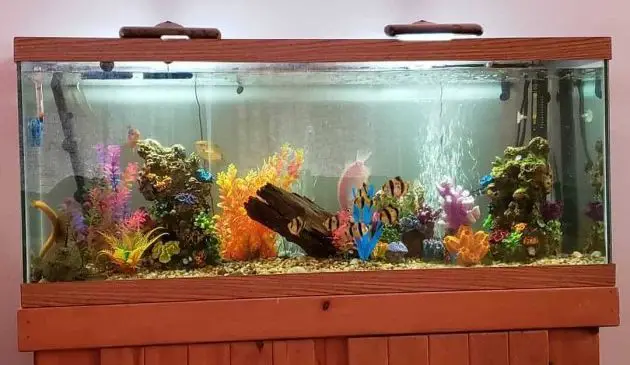
But if you were tending to prefer using gravels, you can still use them in the conditions the sharp gravels must be avoided.
You should plant the hardy and quickly-growing freshwater aquatic plants in their tanks, such as Java Fern, Java Moss, and hornworts. Most aquatic plants can’t survive from your gouramis nibbling. The plastics aquarium plants are more recommended to put in their tank.
Use a gentle filtration system because they prefer and inhabit the slow-flowing waters. You need a heater too, and it will keep the water temperature stable, between 72- 82 °F (22-28 °C).
The standard aquarium lighting is allowed. These tropical fish also can survive in low-tech lighting or even high-tech lighting with enough aquatic plants. It would be best to keep the pH levels between 6 – 8.5 and the hardness between 5-20 dGH.
You can also add another hardscape or decorated such as mountain stone, pipes, or flower pots to give more aesthetic and prevent the fish from ingesting the sands.
Feeding
The Helostoma temminckii is actually freshwater omnivorous fish species. The fine teeth are used for grazing on algae or other vegetation in the wild. You can feed them with green vegetables like spinach, lettuce, or zucchini.
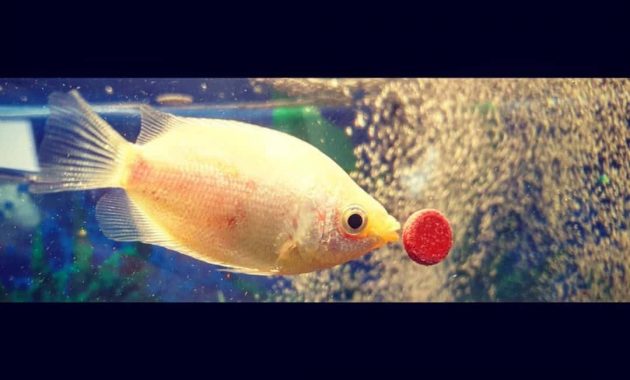
They also tend to hunt some small insects, invertebrates, or plankton in their habitat. Frozen or live foods like daphnia, bloodworms, or brine shrimps are the good choice to replicate their favorite meals.
H. temminckii also accept dried foods like fish pellets from the fish stores. They are not picky eaters, so it will be easiest to find their foods around you.
Tank Mates
Although they are quite aggressive fish species, you still search for other tropical fish species of similar size and have the same characteristics. The smaller fish must be avoided, or they will see it as a snack.

The larger fish tank mates than their size must be avoided too. It will bully your gouramis and make them stressed or tend to spend all their time hiding at some places in the aquarium.
You should monitor them closely to ensure that the kisser does not intimidate their tank mates otherwise. The suitable tank mates may include some cichlids fish species of similar size, loaches, barbs, and some catfish types.
Read Also: Are Axolotls Good Pets For You? It’s A Complete Guide Of Keeping, Feeding, Behavior, Characteristics
Breeding
The kissing fish are oviparous and have external fertilization, and also dioecious. When you start breeding, the first thing is building the breeding aquarium. The water temperature should be warm, around 80 degrees F replicate the wild conditions.
In their habitat, the spawning season usually occurs from May – October at the beginning of the rainy season. You should keep the water hardness in the breeding tank at soft levels.
Feed the mature kissing gouramis with live foods. It can stimulate them to spawn. Then, add some lettuces to the breeding tank. It will shelter the eggs and bring infusoria and bacteria, which become food sources for fry.
When the adults, male and female ready to spawn, they will start to show the peculiar mating ritual. The male will wrap the female body and turning her upside down. At the same time, the female will release eggs, and the male will fertilize them.
Their eggs will float and stick to the lettuce leaves until hatching. This process will cycle many times until the female release all her eggs. The females result in 1000 eggs on averages. Once the spawning process is completed, both male and female adults must be removed from the breeding tank to avoid them predating the eggs.
Their eggs are smooth, able to floating and rounded. It will hatch in after one day. After that, they will continue to consume their sac until they can start free-swimming.
The fry will eat the infusoria around the lettuce leaves until they grow larger and can accept brine shrimps or other larger foods. They normally reach the maturity of 3-5 years.


